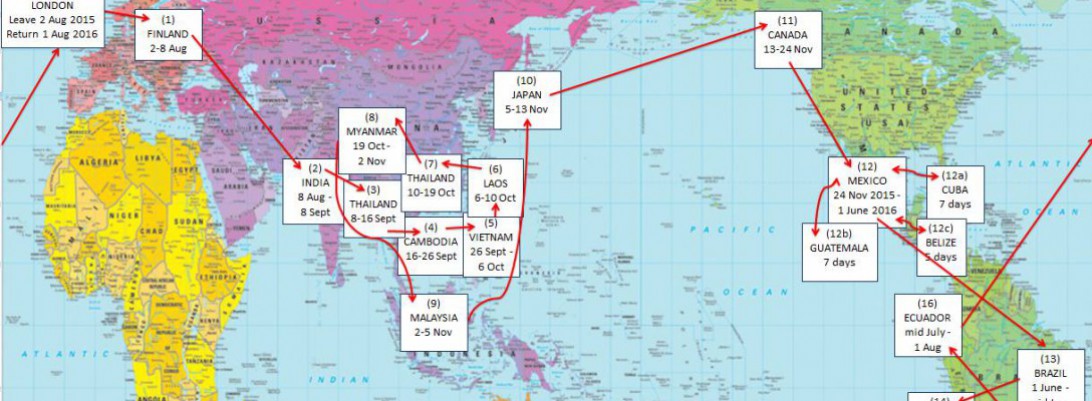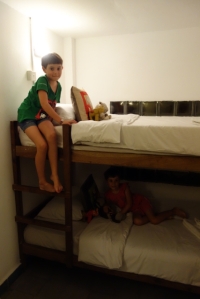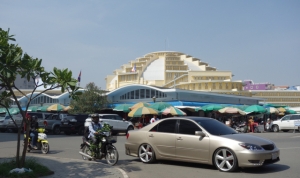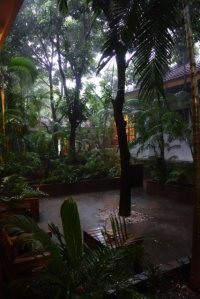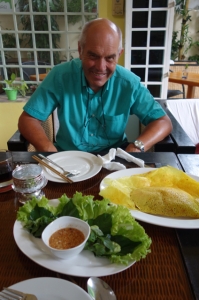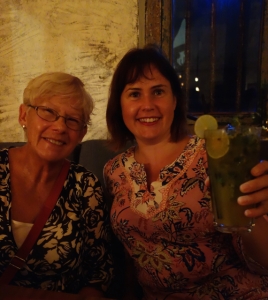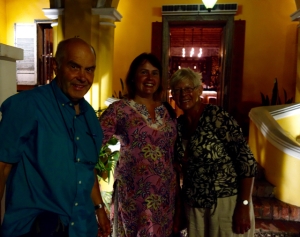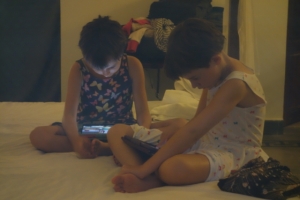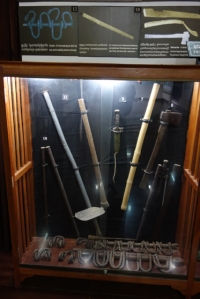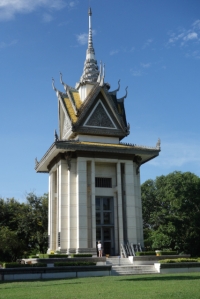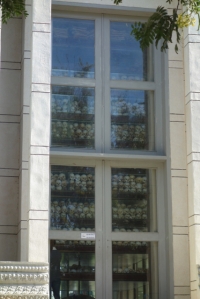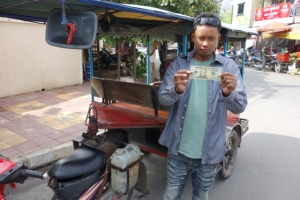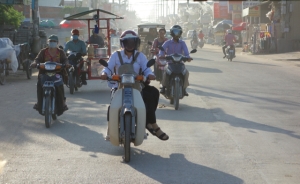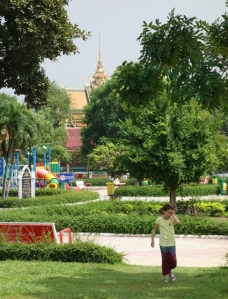
It is amazing how fast human beings adapt to whatever they are doing, and for us, travelling has become the day-to-day norm. We now expect to be packing up, moving on, sleeping in a different bed every couple of nights.
The children are quick at making a routine as soon as we arrive anywhere– setting out their things, fighting over who gets which side of the bed – the usual kid stuff. They are good at lifts – Daisy always knows whether she needs a keycard or not to get to the floor she wants – and professionals at scavenging at a hotel buffet, finding Cartoon Network in every hotel that has a telly, hailing a tuk tuk and wiping their bottoms ‘the hose way’ (as Daisy calls it) – covering the bathroom in water in the process.
I can only assume they’ll be sought-after companions when they finally come to have teenage Gap Years – they already manage a veneer of world-weary travel sophistication that their mother struggles to replicate.
Hotel living is strange though. Will we always expect our toiletries to come in tiny, tiny bottles, and our tea, made in a dinky little kettle, to come with coffee whitener? Will I ever be able to work out where the bathroomis, or find the bedside lamp when I wake up in the night? Sometimes I can’t even remember which country I’m in, so it seems unlikely.
Because South East Asia is so cheap, we can afford a level of comfort that makes the whole thing very pleasant, so perhaps it’s no wonder that we’re enjoying the lifestyle so much. We’ll be slumming it much more when Mum and Dad go, so we need to enjoy it while we can.
While travelling has become the norm, however, there are some places that jolt you out of this new ‘comfort zone’. Sometimes it is because they are uncomfortable, but often it is just sheer incredulity that you are there at all.
For me Phnom Penh afforded some of these moments. The capital city, which I’ve seen on the news so often, was not somewhere I’d ever expected to go. So the night we arrived, floating in the swimming pool under the stars in a beautiful hotel behind the Prime Minister’s residence, was one of those surreal moments when I thought ‘I can’t believe we’re really doing this’ – and felt so very fortunate. Obviously, this transcendental moment was interrupted by the girls squabbling over who had the top bunk, but you can’t have everything.
Phnom Penh is a city on the up, but it hasn’t quite made it there yet. In some places the roads are metalled, but the main road between the capital and second city, Battambang, peters out into dust somewhere in the Phnom Penh suburbs. There are few traffic lights, which creates a bit of an ‘every man for himself’ atmosphere, not to mention some traffic jams that the police seem to have completely given up on – they tend to stand in the middle of them on their phones looking completely defeated.
As a capital, PP couldn’t be more different to Bangkok and Delhi (and later Ha Noi), but the construction work around the edges of the city, including the first shopping malls, indicate that it won’t be this way for long. We enjoy it while it lasts, complete with old world charm, tuk tuk rides, and a night out at one of the trendiest bars I’ve been to in a while – where we are clearly sitting right next to a delegation from the UN. Dad wears his crocs (our time in Phnom Penh is marked by some impressive downpours) and the manager keeps addressing me as Madame Rosemary, which makes me sound as if I run a brothel, but at least we’re out, and there are cocktails. Thanks to the Kabiki, our highly, highly recommended hotel with a babysitting service, the whole thing goes very smoothly.
I confess that, in Phnom Penh, the children barely leave the hotel, which has lots of the things they like, including a children’s menu, free toy elephants, three-day-old kittens, a swimming pool and the aforementioned bunk beds (just like home). It also has other travelling families from the UK and America, so they are delighted to have some partners in crime for swimming races and diving, and we are delighted to swap tips. It’s easy to feel like a bit of a freak/reprobate when travelling with your children, so it’s good to realise you’re not alone.
We leave the hotel though. I take Mum for her first-ever pedicure, at a spa that trains at-risk women. Bonus, I get to feel good and help a charity – and the whole hour only costs £7 each. My feet are working hard at the moment – scarcely out of sandals and tramping round all sorts of places with bags – so I’m sure they appreciated the attention. The link is here if you happen to be going to Phnom Penh – my feet would definitely recommend it.
In a totally ridiculous juxtaposition, Paul, Dad and I then took a trip to the Killing Fields. This place, a boneshaking ride outside the city, was where supposed traitors to Pol Pot’s regime were taken, brutally hacked to death with farm implements (proper weapons were too expensive, apparently), and then pushed into mass graves.
20,000 people were killed here between 1975 and 1978, including babies, women and children, to the accompaniment of blaring revolutionary music to drown out the screams and conceal what was really happening.
The Killing Fields are now peaceful, with butterflies and green trees, and a tall white stupa (like a memorial temple) in the middle filled with some of the skulls and bones of the dead. As you walk around, though, particularly after the rain, you are reminded not to tread on the other bones and bits of cloth that are still surfacing from the mass graves.
I see scraps of children’s clothes, and plenty of bits of bone – but it’s not at all grisly, thanks to the superb audio guide provided, that allows you to walk around the site at your own pace. The recording, made by one of the survivors of Pol Pot’s regime, who first explains his own story, reminds you that virtually every Cambodian you deal with of my age or above will have his or her own tale of this bizarre and terrible time.
He explains how Pol Pot’s unshakeable belief in a Communism that pitted impure city dwellers against heroic peasantry led him to empty the cities of all of their inhabitants. This purge involved killing so-called ‘intellectuals’ for such crimes as wearing glasses, having soft hands, or being a teacher or doctor. With family units broken up, and everyone forced to work in female, male or child agricultural units with an emphasis on rice production for export, thousands upon thousands died of starvation and disease.
Pot (real name Saloth Sar), in the manner of many dictators, grew more and more paranoid, and the number of killings escalated as members of his Khmers Rouges party (known as Angkar) tortured many into false confessions in a former secondary school in Phnom Penh. The Killing Field we visit is just one of many. Most have been left undisturbed. The numbers are terrifying.
In all of this, the West scarcely covered itself with glory. It is uncomfortable to be reminded, while standing in front of a tree where Angkar members killed babies by throwing them against the branches, that even when Pol Pot was forced into hiding after the Vietnamese liberated Cambodia, Britain and the US still recognised the Khmers Rouges as the official government of Vietnam – such was the dislike of Vietnamese communism, and the determination to stop it spreading.
The audio guide suggests that Pol Pot’s revolution wouldn’t have been possible in the first place if the country had not been bombed so heavily during the American war with Vietnam that there was little strength or cohesion amongst the people.
Lots to think about. Sobering to remember that almost everyone in Cambodia is a survivor – and thrilling to see the country rebuilding itself, despite other issues with poverty, lack of democracy, people trafficking and, when we visited, massive flooding that is hardly going to be helped by the explosion in construction work.
Recovery is a long road, with the Cambodian equivalent of the Truth & Reconciliation Committee still ongoing, and the countryside littered with unexploded ordnance.
It’s a sobering note on which to leave Cambodia, but as we travel on, by land, through the Vietnam border towards Ho Chi Minh City, I get the feeling that if we pass this way again, we will be in a very different place. Cambodia is changing faster than almost anywhere I’ve visited. I pray that it, and all of its people, will rise.
ENDS

